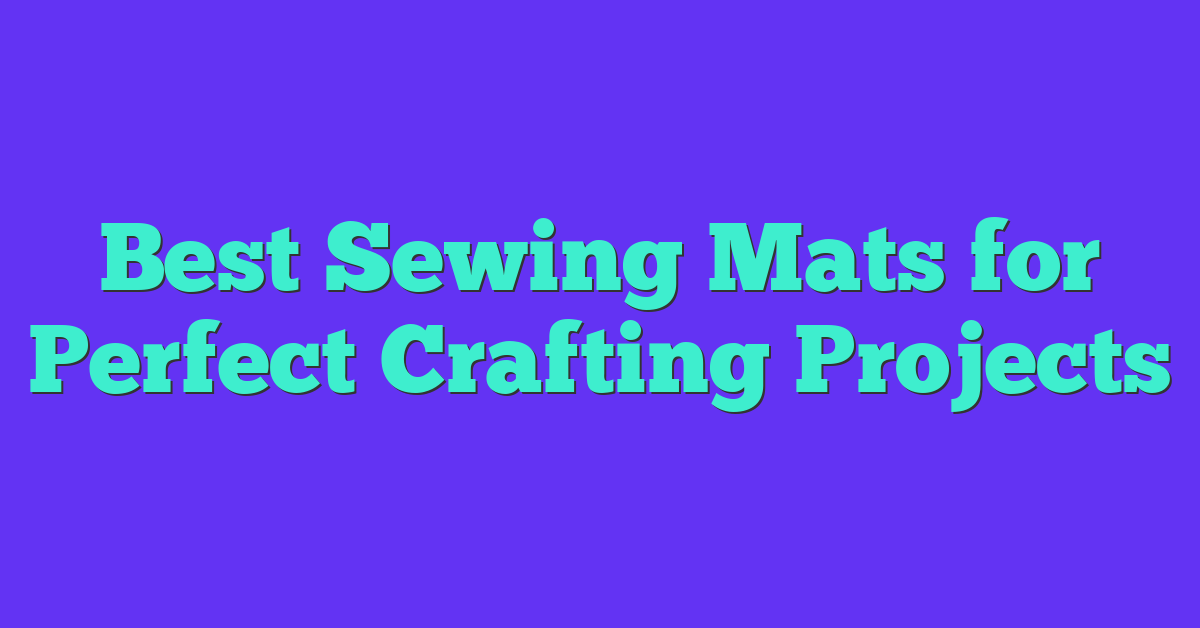There’s something truly special about creating a meditation cushion with your own hands. Not only does it provide a comfortable spot for your practice, but it also adds a personal touch to your space. I’ve found that sewing a fabric meditation cushion can be a meditative experience in itself, allowing me to focus on the rhythmic motions of stitching while crafting a cozy haven for my mindfulness moments.
Benefits of a Fabric Meditation Cushion
Creating a fabric meditation cushion offers numerous benefits that enhance meditation practices.
- Comfort: A personalized cushion provides tailored support for your body. You can choose the filling that suits your comfort level, ensuring stability during meditation.
- Alignment: An appropriate height and firmness promote proper posture. Maintaining alignment helps prevent discomfort and allows for longer meditation sessions.
- Aesthetics: Selecting fabrics that resonate with your personal style adds a pleasing visual element. You can use colors and patterns that inspire tranquility or stimulate creativity.
- Mindfulness: The act of sewing fosters mindfulness. Focusing on each stitch helps reduce stress and cultivates a meditative state, making the cushion a reflection of your practice.
- Durability: Handmade cushions often last longer than store-bought ones. Choosing high-quality materials ensures that your cushion withstands regular use.
- Sustainability: Using eco-friendly fabrics supports sustainable practices. When you create your cushion, you can opt for materials that minimize environmental impact.
- Customization: A fabric cushion can be tailored to specific needs. Consider incorporating pockets for essentials or adding a removable cover for easy cleaning.
Investing time in creating a fabric meditation cushion enhances not just your meditation practice but your overall well-being.
Materials Needed for Sewing a Fabric Meditation Cushion
Creating a fabric meditation cushion requires specific materials to ensure comfort and durability. Below are the necessary components for this project.
Choosing the Right Fabric
Selecting the ideal fabric is crucial for both comfort and aesthetics. I recommend using natural fibers such as cotton, linen, or canvas for breathability and softness. Look for upholstery fabric or heavier weight cotton to ensure durability. Consider colors and patterns that resonate with your personal style. When choosing, check for pre-washing and shrinkage characteristics, ensuring the fabric maintains its shape and feel after washing.
Selecting the Filling
Finding the right filling enhances the cushion’s support and comfort. Common choices include buckwheat hulls, kapok, or foam. Buckwheat hulls offer adjustable support and are eco-friendly. Kapok provides a soft, plush feel while being biodegradable. Foam cushions give firm support and can be cut to size. Ensure the filling fits the intended height and firmness for proper alignment during meditation.
Step-by-Step Guide to Sewing a Fabric Meditation Cushion
Creating a fabric meditation cushion involves a series of straightforward steps. Following this guide ensures a comfortable and aesthetically pleasing result that enhances meditation practice.
Preparing the Fabric
- Choose fabric: Select a durable, natural fiber like cotton, linen, or canvas for comfort and durability.
- Prewash fabric: Soak and wash the fabric to avoid future shrinkage, ensuring accuracy in measurements.
- Cut fabric: Measure and cut two pieces of fabric, typically around 20 inches square or as desired for your cushion size. Add an extra inch for seam allowance.
- Iron pieces: Press the fabric to remove wrinkles, allowing for precise sewing.
Assembling the Cushion
- Place fabric right sides together: Align both pieces of fabric so the sides with the printed or colored patterns face inward.
- Pin edges: Secure the fabric using pins along the edges to prevent shifting during sewing.
- Sew sides: Stitch around the perimeter with a ½-inch seam allowance, leaving about a 6-inch opening on one side for turning and stuffing.
- Trim corners: Cut the corners at a diagonal to reduce bulk, allowing a cleaner finish when turning the cushion right side out.
- Turn cushion right side out: Carefully pull the fabric through the opening, ensuring the corners are pushed out smoothly.
Adding Finishing Touches
- Prepare filling: Decide on the filling material, such as buckwheat hulls, kapok, or foam, ensuring it suits personal comfort preferences.
- Stuff cushion: Fill the cushion through the opening, adjusting the amount to achieve the desired firmness and height for support during meditation.
- Close the opening: Fold in the raw edges of the fabric at the opening and use a slip stitch or sewing machine to secure it closed neatly.
- Final press: Iron the cushion for a polished look, and ensure all seams are smooth and intact.
Each of these steps brings me one step closer to enjoying my personalized meditation space, reflecting both comfort and style.
Tips for Using Your Meditation Cushion
Using your handmade meditation cushion enhances the meditative experience. Here are some helpful tips:
- Choose the Right Spot: Select a quiet, comfortable area for meditation. A serene environment promotes focus and relaxation.
- Adjust the Height: Experiment with different amounts of filling. Adjusting the height ensures proper alignment for your body and comfort during meditation.
- Sit Cross-Legged: Sit in a cross-legged position on the cushion. This alignment allows for stability and promotes an open hip position.
- Maintain Good Posture: Keep your back straight and shoulders relaxed. Engaging your core supports a balanced posture while meditating.
- Incorporate Props: Use additional props like blankets or bolsters for added comfort. These items provide support where needed.
- Practice Consistently: Regular use of your cushion reinforces a meditation habit. Consistency builds focus and deepens the practice.
- Clean Regularly: Maintain your cushion’s cleanliness by spot-cleaning or washing the fabric as needed. A clean cushion keeps the meditation space inviting.
- Explore Different Positions: Experiment with various seating positions. Alternate styles could enhance comfort and relaxation.
Implementing these tips cultivates a deeper, more rewarding meditation practice, allowing for mindfulness and peace in your daily routine.
Conclusion
Creating a fabric meditation cushion has truly been a rewarding journey for me. Not only do I get to enjoy the comfort and support tailored to my needs but the whole process of sewing brings a sense of calm and mindfulness. Each stitch feels like a step closer to enhancing my meditation practice.
I love how my cushion reflects my personal style and adds a special touch to my meditation space. It’s amazing to think that I’ve crafted something that not only supports my body but also nurtures my mind. I can’t wait to see how my practice evolves with this beautiful handmade piece. If you’re considering making your own cushion I highly encourage you to dive in and experience the joy it brings.

















